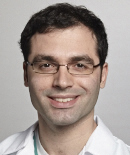- High-stakes Simulation-based Assessment for Retraining and Returning Physicians to Practice (SS05)
- Duration of Anesthesiology 2017
- Self-Study Kiosks on BCEC Level 1, Northeast & Northwest Lobby
Simulation has become a popular and effective method of assessing the competency of anesthesiologists returning to practice after time off. It also is used to assess the skills of physicians whose professionalism is in question. An ANESTHESIOLOGY 2017 Self-Study course explains how to develop a retraining simulator program.
The course is presented by three faculty members from the Icahn School of Medicine at Mount Sinai, where the first anesthesiology assessment and retraining simulator program was developed more than a decade ago. The presenters explain the medicolegal background that drove the development of the program and retraining principles. They also present their personal experiences gathered over the last decade.

Andrew T. Goldberg, M.D.
The simulation program was first used to evaluate an anesthesiologist who had not done well on a multiple-choice assessment exam taken because of practice concerns, said the course moderator Andrew T. Goldberg, M.D. When tested in a simulator, the physician demonstrated that he knew the basics of the work.
“It was clear that some of his book knowledge had lapsed, and we actually created kind of a prescription for remediation. We believed it was possible we could retrain people using the simulated environment,” said Dr. Goldberg, an Assistant Professor of Anesthesiology and Director of Research for the Mount Sinai Human Emulation Lab for Patient Safety (HELPS).
Today, about half of the anesthesiologists going through the HELPS program participate for retraining after taking a leave and the other half were investigated by state licensing boards for professionalism issues and drug diversion, he said
The course explains the principles established by the American Medical Association for successful retraining and re-entry into practice. It also addresses the challenges the HELPS program has recognized, with some details of the assessment and training.
“These are the nuts and bolts of how long it lasts, how many scenarios you see and what kinds of things we throw at participants,” Dr. Goldberg said. “It is important to note that everything we do is completely individualized based on who we are dealing with.
“If someone gets sent to us for professionalism issues, we don’t belabor a lot of the basic anesthesiology points. Instead, we put them in difficult scenarios in the operating room where the unprofessional behavior could come out. That is very different from the person who is coming to us after a voluntary leave of absence to raise a family. They may need to start over because they do not remember a lot of the basic anesthesiology principles.”
The course emphasizes the need for a simulator program to be customized for each participant.
“It is critical when creating a program like this to not have too many hard and fast rules for yourself,” Dr. Goldberg said. “You test the practitioner’s knowledge with the standard things, like difficult airway scenarios. Besides that, you should use it as a forum to individualize practice and make sure the person can do everything you throw at them rather than just having the set scenarios you give to everybody. It is important to roll with the punches based on who you are assessing.”
Return to Archive Index